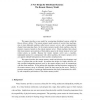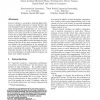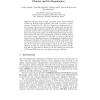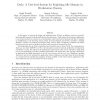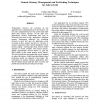USENIX
1990
14 years 10 months ago
1990
This paper describes a new model for constructing distributed systems called the Remote Memory Model. The remote memory model consists of several client machines, one or more dedi...
MASCOTS
1996
14 years 10 months ago
1996
The increasing use of high-bandwidth and low-latency networks make possible the use of remote (network) memory as an alternative to disk means of storing an application's dat...
CLUSTER
2009
IEEE
15 years 19 days ago
2009
IEEE
—The 64-bit OS provides ample memory address space that is beneficial for applications using a large amount of data. This paper proposes using a cluster as a memory resource for...
ISCA
1995
IEEE
15 years 27 days ago
1995
IEEE
Latency tolerance is essential in achieving high performance on parallel computers for remote function calls and fine-grained remote memory accesses. EM-X supports interprocessor ...
HPCA
1997
IEEE
15 years 1 months ago
1997
IEEE
Many parallel systems offer a simple view of memory: all storage cells are addresseduniformly. Despite a uniform view of the memory, the machines differsignificantly in theirmemo...
IPPS
1998
IEEE
15 years 1 months ago
1998
IEEE
We have built an eight node SMP cluster called COMPaS (Cluster Of Multi-Processor Systems), each node of which is a quadprocessor Pentium Pro PC. We have designed and implemented a...
ICPADS
1998
IEEE
15 years 1 months ago
1998
IEEE
: Three fast mutual exclusion algorithms using read-modify-write and atomic read/write registers are presented in a sequence, with an improvement from one to the next. The last alg...
HPDC
1999
IEEE
15 years 1 months ago
1999
IEEE
In this paper, we present the design and implementation of Dodo, an e cient user-level system for harvesting idle memory in o -the-shelf clusters of workstations. Dodo enables dat...
HPCS
2002
IEEE
15 years 2 months ago
2002
IEEE
Thread migration is one approach to remote memory accesses on distributed memory parallel computers. In thread migration, threads of control migrate between processors to access d...
SKG
2006
IEEE
15 years 3 months ago
2006
IEEE
Predominant resources for execution of any application are computational power and memory. On one side, computational power has grown many folds faster than memory capacity. On th...
